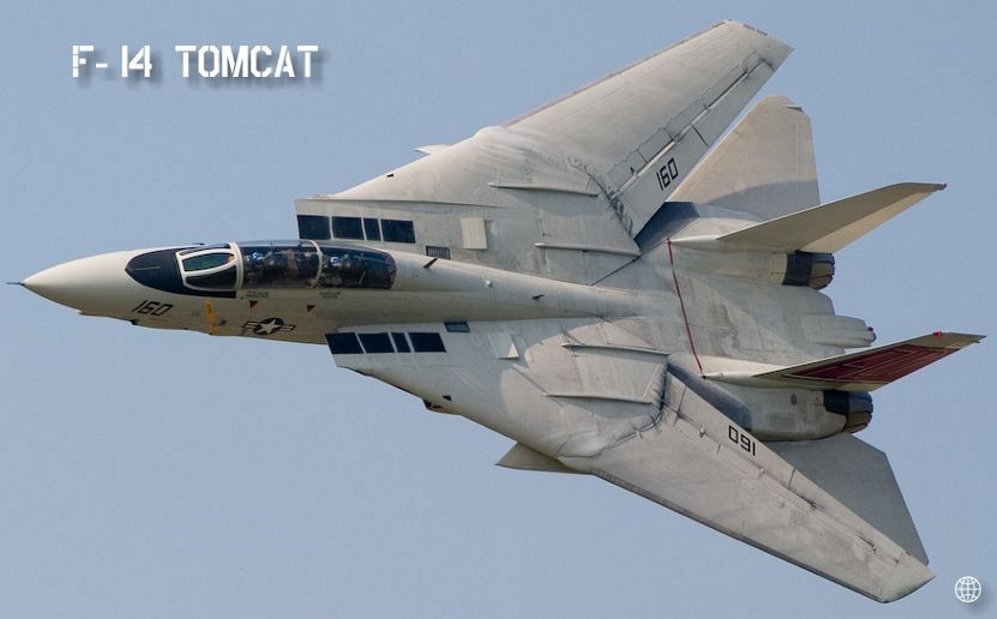F-14 TOMCAT FIGHTER, USA

The F-14 Tomcat is the US Navy's carrier-based two-seat air defence, intercept, strike and reconnaissance aircraft. The aircraft was developed by Northrop Grumman to replace the F-4 Phantom fighter and entered service with the US Navy in 1972. In 1987, the F-14B with an upgraded engine went into production. Further upgrades in the radar, avionics and missile capability resulted in the F-14D Super Tomcat, which first flew in 1988. The US Navy operated 338 F-14 aircraft of all three variants, but the aircraft is being replaced by the F/A-18E/F Super Hornet. F-14 squadrons have started to change to the new aircraft; this process will continue until the aircraft is finally retired from service in 2007.
The variable sweep wing and the twin almost upright tail fins of the F-14 Tomcat give the aircraft its distinctive appearance. The variable sweep wings are set at 20° for take-off, loitering and landing, and automatically change to a maximum sweep of 68°, which reduces drag for high subsonic to supersonic speeds. The wings are swept at 75° for aircraft carrier stowage.
COCKPIT
Catseye night-vision goggles have been installed in the F-14 since 1996 and are supplied by BAE SYSTEMS. The F-14D front cockpit is equipped with a head-up display and two multifunction flat-screen displays. The rear cockpit for the Radar Intercept Officer is equipped with a display that presents fused data from the AN/APG-71 radar and from the suite of aircraft sensors.
82 US Navy F-14Bs are being upgraded with Flight Visions, Inc. Sparrow Hawk HUD and FV-3000 modular mission display system, which will improve reliability and night-vision capability. The cockpit is equipped with the NACES zero/zero ejection seat supplied by Martin Baker Aircraft Company.
WEAPONS
The F-14 is armed with a General Electric Vulcan M61A-1 20mm gun with 675 rounds of ammunition, which is mounted internally in the forward section of the fuselage on the port side. The aircraft has eight hardpoints for carrying ordnance: four on the fuselage and two each side under the fixed section of the wings. The aircraft can carry the short-, medium- and long-range air-to-air missiles AIM-9, AIM-7 and AIM-54, and air-to-ground ordnance including the Rockeye bomb and CBU cluster bombs. Raytheon AIM-7 Sparrow is a medium-range radar-guided air-to-air missile with range of 45km. Lockheed Martin/Raytheon AIM-9 Sidewinder is a short-range air-to-air missile with a range of 8km. Raytheon AIM-54 Phoenix is a long-range air-to-air missile with a range of 150km. The F-14 can carry up to six Phoenix missiles and is capable of firing the missiles almost simultaneously at six different targets. The Phoenix missile was retired from US Navy service in October 2004.
The F-14D can carry four Joint Direct Attack Munitions (JDAM). First operational deployment of a precision-guided JDAM from an F-14 was in March 2003.
In 1995, the US Navy installed the Lockheed Martin LANTIRN precision strike navigation and targeting pod on the F-14. The LANTIRN targeting pod includes a dual-field-of-view FLIR and a laser designator/rangefinder. The navigation pod also contains a FLIR and terrain-following radar. A Lockheed Martin infrared search and track system is installed in a sensor pod under the nose.
SENSORS
The F-14D is equipped with a Raytheon AN/APG-71 digital multi-mode radar, which provides non-cooperative target identification, and incorporates low sidelobe techniques and enhanced frequency agility.
The F-14 carries a tactical air reconnaissance pod system (TARPS), which carries a Recon/Optical KS-87B forward or vertical frame camera, and a low-altitude panoramic view KA-99 camera, together with a Lockheed Martin AN/AAD-5 infrared linescanner. The pod is equipped with a digital imaging system for the transmission of near real-time imagery to the aircraft carrier command centre via a secure UHF radio data link. To supplement TARPS, US Navy F-14s are also being fitted with a fast tactical imagery (FTI) system, which is a line-of-sight system for targeting and reconnaissance.
COUNTERMEASURES
The aircraft is equipped with the BAE Systems Integrated Defense Solutions (formerly Tracor) and Lockheed Martin AN/ALE-39 and AN/ALE-29 chaff, flare and decoy dispensers. The Super Tomcat has a Raytheon AN/ALR-67(V)4 radar warning system and BAE Systems Information & Electronic Warfare Systems (IEWS) (formerly Sanders) AN/ALQ-126 jammer.
ENGINE
The F-14B and the F-14D have two General Electric F110-GE-400 turbofan engines, rated at 72kN and 120kN with afterburn. There are five internal fuel tanks, which carry 9,000 litres and are located in the fixed section and the outer section of the wings, and in the rear section of the fuselage between the engines.